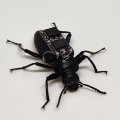Electrical parts made of soft, durable plastic could soon replace silicon chips and toxic metals in consumer goods if Dr Paul Meredith has his way.
Dr Meredith, a senior lecturer in UQ’s School of Physical Sciences, receives $80,000 in the UQ Foundation Research Excellence Awards, which are a highlight of UQ Research Week 2005 this week.
He is learning more about bio-organic polymers that conduct electricity.
Dr Meredith said his research on electronic biomaterials focused on melanin, a pigment in humans that colours our skin, eyes and hair, and are also found in squid ink.
Melanin, in its purest form as a black, odourless powder, conducts electricity and can also be made to generate electricity from sunlight.
“If you extract this material from pigment containing tissue such as hair or skin and make a solid pellet out of it, it conducts electricity,” Dr Meredith said.
The ultimate goal of his group, the Soft Condensed Matter Physics Group, is to understand more about the physics and chemistry of this biological material and build low cost, environmentally friendly electrical devices from it.
Dr Meredith’s group has already built a prototype sensor with melanin that measures water content but they are also building an organic chemical sensor and transistor.
He said there was a big push to use plastic electronic materials instead of expensive silica and toxic gallium arsenide for electrical componentry.
“There is a growing realisation that we should move on from the inorganic semiconductors that have served us so well for over five decades. We need cheaper, safer electronic materials with greener credentials,” he said.
“We can molecularly engineer them [electronic biomaterials], make new variants of them, amplify their properties, build new devices and make electronic devices based on bioavailable materials, which is the Holy Grail.
“After their useful lifetime, many polymers can be mashed up into a big melt and recast to create new things which are infinitely recyclable."
It was feasible that people could watch a flat screen TV with a plastic circuit board and screen which could be rolled up.
“That’s the ultimate goal. That means developing materials and processes and devices across a broad range of technology platforms," he said.
“Everything from building small transistors all the way up to the emitting screen itself.”
Dr Meredith said the Soft Matter group consisted of chemists, biophysicists and physicists who worked closely with UQ’s Condensed Matter Theory Group and counterparts in the University of NSW.
Media: For further information please contact Dr Paul Meredith, telephone 07 3365 7050. For pix of Dr Meredith, please contact Diana Lilley, telephone 07 3365 2753.
.jpg)

